A High-Finesse Suspended Interferometric Sensor for Macroscopic Quantum Mechanics with Femtometre Sensitivity
Abstract
1. Introduction
2. Experimental Layout
2.1. Optical System
2.2. Suspension
2.3. Active Isolation
2.4. Results
3. Conclusions
Author Contributions
Funding
Institutional Review Board Statement
Informed Consent Statement
Data Availability Statement
Acknowledgments
Conflicts of Interest
Abbreviations
| ADC | Analogue-to-digital converter |
| AdV | Advanced Virgo |
| aLIGO | Advanced LIGO |
| BOSEM | Birmingham optical sensor and electromagnetic motor |
| CDS | Control and data system |
| DoF | Degree of freedom |
| FSR | Free spectral range |
| GW | Gravitational wave |
| ISI | Internal seismic isolation |
| ISS | Intensity stabilisation servo |
| PLL | Phase lock loop |
| QRPN | Quantum radiation pressure noise |
| QSN | Quantum shot noise |
| RMS | Root mean square |
| SQL | Standard quantum limit |
| VCO | Voltage-controlled oscillator |
| VOA | Variable optical attenuator |
References
- Metcalf, H.J.; van der Straten, P. Laser cooling and trapping of atoms. J. Opt. Soc. Am. B 2003, 20, 887–908. [Google Scholar] [CrossRef]
- Adams, C.; Carnal, O.; Mlynek, J. Atom Interferometry. In Advances in Atomic, Molecular, and Optical Physics; Academic Press: Cambridge, MA, USA, 1994; Volume 34, pp. 1–33. [Google Scholar] [CrossRef]
- Badurina, L.; Bentine, E.; Blas, D.; Bongs, K.; Bortoletto, D.; Bowcock, T.; Bridges, K.; Bowden, W.; Buchmueller, O.; Burrage, C.; et al. AION: An atom interferometer observatory and network. J. Cosmol. Astropart. Phys. 2020, 2020, 011. [Google Scholar] [CrossRef]
- Aasi, J.; Abbott, B.P.; Abbott, R.; Abbott, T.; Abernathy, M.R.; Ackley, K.; Adams, C.; Adams, T.; Addesso, P.; Adhikari, R.X.; et al. Advanced LIGO. Class. Quantum Gravity 2015, 32, 074001. [Google Scholar] [CrossRef]
- Acernese, F.A.; Agathos, M.; Agatsuma, K.; Aisa, D.; Allem, N.; Allocca, A.; Amarni, J.; Astone, P.; Balestri, G.; Ballardin, G.; et al. Advanced Virgo: A second-generation interferometric gravitational wave detector. Class. Quantum Gravity 2015, 32, 024001. [Google Scholar] [CrossRef]
- Buikema, A.; Cahillane, C.; Mansell, G.L.; Blair, C.D.; Abbott, R.; Adams, C.; Adhikari, R.X.; Ananyeva, A.; Appert, S.; Arai, K.; et al. Sensitivity and performance of the Advanced LIGO detectors in the third observing run. Phys. Rev. D 2020, 102, 062003. [Google Scholar] [CrossRef]
- Abbott, B.P.; Abbott, R.; Abbott, T.; Abernathy, M.R.; Acernese, F.; Ackley, K.; Adams, C.; Adams, T.; Addesso, P.; Adhikari, R.X.; et al. Observation of Gravitational Waves from a Binary Black Hole Merger. Phys. Rev. Lett. 2016, 116, 061102. [Google Scholar] [CrossRef] [PubMed]
- Abbott, B.P.; Abbott, R.; Abbott, T.; Abraham, S.; Acernese, F.; Ackley, K.; Adams, C.; Adhikari, R.X.; Adya, V.B.; Affeldt, C.; et al. GWTC-1: A Gravitational-Wave Transient Catalog of Compact Binary Mergers Observed by LIGO and Virgo during the First and Second Observing Runs. Phys. Rev. X 2019, 9, 031040. [Google Scholar] [CrossRef]
- Abbott, R.; Abbott, T.D.; Abraham, S.; Acernese, F.; Ackley, K.; Adams, A.; Adams, C.; Adhikari, R.X.; Adya, V.B.; Affeldt, C.; et al. GWTC-2: Compact Binary Coalescences Observed by LIGO and Virgo during the First Half of the Third Observing Run. Phys. Rev. X 2021, 11, 021053. [Google Scholar] [CrossRef]
- TLS Collaboration; the Virgo Collaboration; the KAGRA Collaboration; Abbott, R.; Abbott, T.D.; Acernese, F.; Ackley, K.; Adams, C.; Adhikari, N.; Adhikari, R.X.; et al. GWTC-3: Compact Binary Coalescences Observed by LIGO and Virgo During the Second Part of the Third Observing Run. arXiv 2021, arXiv:2111.03606. [Google Scholar]
- Mehta, A.K.; Buonanno, A.; Cotesta, R.; Ghosh, A.; Sennett, N.; Steinhoff, J. Tests of general relativity with gravitational-wave observations using a flexible theory-independent method. Phys. Rev. D 2023, 107, 044020. [Google Scholar] [CrossRef]
- Abbott, R.; Abbott, T.D.; Abraham, S.; Acernese, F.; Ackley, K.; Adams, A.; Adams, C.; Adhikari, R.X.; Adya, V.B.; Affeldt, C.; et al. Population Properties of Compact Objects from the Second LIGO–Virgo Gravitational-Wave Transient Catalog. Astrophys. J. Lett. 2021, 913, L7. [Google Scholar] [CrossRef]
- Abbott, B.P.; Abbott, R.; Abbott, T.D.; Acernese, F.; Ackley, K.; Adams, C.; Adams, T.; Addesso, P.; Adhikari, R.X.; Adya, V.B.; et al. GW170817: Measurements of Neutron Star Radii and Equation of State. Phys. Rev. Lett. 2018, 121, 161101. [Google Scholar] [CrossRef]
- Reitze, D.; Adhikari, R.X.; Ballmer, S.; Barish, B.; Barsotti, L.; Billingsley, G.; Brown, D.A.; Chen, Y.; Coyne, D.; Eisenstein, R.; et al. Cosmic Explorer: The U.S. Contribution to Gravitational-Wave Astronomy beyond LIGO. arXiv 2019, arXiv:1907.04833. [Google Scholar]
- ET Steering Committee Editorial Team. Einstein Telescope Design Report Update 2020; Einstein Telescope Collaboration: Paris, France, 2020. [Google Scholar]
- Amaro-Seoane, P.; Audley, H.; Babak, S.; Baker, J.; Barausse, E.; Bender, P.; Berti, E.; Binetruy, P.; Born, M.; Bortoluzzi, D.; et al. Laser Interferometer Space Antenna. arXiv 2017, arXiv:1702.00786. [Google Scholar]
- Bähre, R.; Döbrich, B.; Dreyling-Eschweiler, J.; Ghazaryan, S.; Hodajerdi, R.; Horns, D.; Januschek, F.; Knabbe, E.A.; Lindner, A.; Notz, D.; et al. Any light particle search II—Technical Design Report. J. Instrum. 2013, 8, T09001. [Google Scholar] [CrossRef]
- Oshima, Y.; Fujimoto, H.; Kume, J.; Morisaki, S.; Nagano, K.; Fujita, T.; Obata, I.; Nishizawa, A.; Michimura, Y.; Ando, M. First Results of Axion Dark Matter Search with DANCE. arXiv 2023, arXiv:2303.03594. [Google Scholar] [CrossRef]
- Heinze, J.; Gill, A.; Dmitriev, A.; Smetana, J.; Yan, T.; Boyer, V.; Martynov, D.; Evans, M. First results of the Laser-Interferometric Detector for Axions (LIDA). arXiv 2023, arXiv:2307.01365. [Google Scholar]
- Chou, A.S.; Gustafson, R.; Hogan, C.; Kamai, B.; Kwon, O.; Lanza, R.; McCuller, L.; Meyer, S.S.; Richardson, J.; Stoughton, C.; et al. First Measurements of High Frequency Cross-Spectra from a Pair of Large Michelson Interferometers. Phys. Rev. Lett. 2016, 117, 111102. [Google Scholar] [CrossRef] [PubMed]
- Richardson, J.W.; Kwon, O.; Gustafson, H.R.; Hogan, C.; Kamai, B.L.; McCuller, L.P.; Meyer, S.S.; Stoughton, C.; Tomlin, R.E.; Weiss, R. Interferometric Constraints on Spacelike Coherent Rotational Fluctuations. Phys. Rev. Lett. 2021, 126, 241301. [Google Scholar] [CrossRef]
- Pan, J.W.; Chen, Z.B.; Lu, C.Y.; Weinfurter, H.; Zeilinger, A.; Żukowski, M. Multiphoton entanglement and interferometry. Rev. Mod. Phys. 2012, 84, 777–838. [Google Scholar] [CrossRef]
- Caves, C.M.; Schumaker, B.L. New formalism for two-photon quantum optics. I. Quadrature phases and squeezed states. Phys. Rev. A 1985, 31, 3068–3092. [Google Scholar] [CrossRef] [PubMed]
- Schumaker, B.L.; Caves, C.M. New formalism for two-photon quantum optics. II. Mathematical foundation and compact notation. Phys. Rev. A 1985, 31, 3093–3111. [Google Scholar] [CrossRef] [PubMed]
- Caves, C.M. Quantum-Mechanical Radiation-Pressure Fluctuations in an Interferometer. Phys. Rev. Lett. 1980, 45, 75–79. [Google Scholar] [CrossRef]
- Miao, H.; Chen, Y. Quantum theory of laser interferometer gravitational wave detectors. In Advanced Gravitational Wave Detectors; Blair, D.G., Ju, L., Zhao, C., Howell, E.J., Eds.; Cambridge University Press: Cambridge, UK, 2012; pp. 277–297. [Google Scholar] [CrossRef]
- Braginsky, V.B. Classical and Quantum Restrictions on the Detection of Weak Disturbances of a Macroscopic Oscillator. J. Exp. Theor. Phys. 1968, 26, 831. [Google Scholar]
- Caves, C.M. Quantum-mechanical noise in an interferometer. Phys. Rev. D 1981, 23, 1693–1708. [Google Scholar] [CrossRef]
- Schnabel, R. Squeezed states of light and their applications in laser interferometers. Phys. Rep. 2017, 684, 1–51. [Google Scholar] [CrossRef]
- Südbeck, J.; Steinlechner, S.; Korobko, M.; Schnabel, R. Demonstration of interferometer enhancement through Einstein-Podolsky-Rosen entanglement. Nat. Photonics 2020, 14, 240–244. [Google Scholar] [CrossRef]
- McCuller, L.; Whittle, C.; Ganapathy, D.; Komori, K.; Tse, M.; Fernandez-Galiana, A.; Barsotti, L.; Fritschel, P.; MacInnis, M.; Matichard, F.; et al. Frequency-Dependent Squeezing for Advanced LIGO. Phys. Rev. Lett. 2020, 124, 171102. [Google Scholar] [CrossRef]
- Aasi, J.; Abadie, J.; Abbott, B.P.; Abbott, R.; Abbott, T.D.; Abernathy, M.R.; Adams, C.; Adams, T.; Addesso, P.; Adhikari, R.X.; et al. Enhanced sensitivity of the LIGO gravitational wave detector by using squeezed states of light. Nat. Photonics 2013, 7, 613–619. [Google Scholar] [CrossRef]
- Acernese, F.; Agathos, M.; Aiello, L.; Allocca, A.; Amato, A.; Ansoldi, S.; Antier, S.; Arène, M.; Arnaud, N.; Ascenzi, S.; et al. Increasing the Astrophysical Reach of the Advanced Virgo Detector via the Application of Squeezed Vacuum States of Light. Phys. Rev. Lett. 2019, 123, 231108. [Google Scholar] [CrossRef]
- Bentley, J.; Jones, P.; Martynov, D.; Freise, A.; Miao, H. Converting the signal-recycling cavity into an unstable optomechanical filter to enhance the detection bandwidth of gravitational-wave detectors. Phys. Rev. D 2019, 99, 102001. [Google Scholar] [CrossRef]
- Li, X.; Smetana, J.; Ubhi, A.S.; Bentley, J.; Chen, Y.; Ma, Y.; Miao, H.; Martynov, D. Enhancing interferometer sensitivity without sacrificing bandwidth and stability: Beyond single-mode and resolved-sideband approximation. Phys. Rev. D 2021, 103, 122001. [Google Scholar] [CrossRef]
- Dmitriev, A.; Miao, H.; Martynov, D. Enhancing the sensitivity of interferometers with stable phase-insensitive quantum filters. Phys. Rev. D 2022, 106, 022007. [Google Scholar] [CrossRef]
- Bersanetti, D.; Patricelli, B.; Piccinni, O.J.; Piergiovanni, F.; Salemi, F.; Sequino, V. Advanced Virgo: Status of the Detector, Latest Results and Future Prospects. Universe 2021, 7, 322. [Google Scholar] [CrossRef]
- Müller-Ebhardt, H.; Rehbein, H.; Schnabel, R.; Danzmann, K.; Chen, Y. Entanglement of Macroscopic Test Masses and the Standard Quantum Limit in Laser Interferometry. Phys. Rev. Lett. 2008, 100, 013601. [Google Scholar] [CrossRef] [PubMed]
- Yang, H.; Miao, H.; Lee, D.S.; Helou, B.; Chen, Y. Macroscopic Quantum Mechanics in a Classical Spacetime. Phys. Rev. Lett. 2013, 110, 170401. [Google Scholar] [CrossRef] [PubMed]
- Miao, H.; Martynov, D.; Yang, H.; Datta, A. Quantum correlations of light mediated by gravity. Phys. Rev. A 2020, 101, 063804. [Google Scholar] [CrossRef]
- Rao, Y.; Culshaw, B. Comparison between optically excited vibrations of silicon cantilever and bridge microresonators. Sensors Actuators A Phys. 1992, 30, 203–208. [Google Scholar] [CrossRef]
- Sidles, J.A.; Sigg, D. Optical torques in suspended Fabry–Perot interferometers. Phys. Lett. A 2006, 354, 167–172. [Google Scholar] [CrossRef]
- Wipf, C. Toward Quantum Opto-Mechanics in a Gram-Scale Suspended Mirror Interferometer. Ph.D. Thesis, Massachusetts Institute of Technology, Cambridge, MA, USA, 2013. [Google Scholar]
- Westphal, T.; Bergmann, G.; Bertolini, A.; Born, M.; Chen, Y.; Cumming, A.V.; Cunningham, L.; Dahl, K.; Gräf, C.; Hammond, G.; et al. Design of the 10 m AEI prototype facility for interferometry studies. Appl. Phys. B 2012, 106, 551–557. [Google Scholar] [CrossRef]
- Smetana, J.; Martynov, D. Towards the Standard Quantum Limit in a Table-Top Interferometer. In Proceedings of the GRavitational-Waves Science & Technology Symposium (GRASS) 2019, Padova, Italy, 30 March 2020. [Google Scholar] [CrossRef]
- Smetana, J.; Yan, T.; Boyer, V.; Martynov, D. Reaching a macroscopic quantum state in a suspended interferometer. In Proceedings of the Quantum Technology: Driving Commercialisation of an Enabling Science III, Birmingham, UK, 7–8 December 2022; Padgett, M.J., Bongs, K., Fedrizzi, A., Politi, A., Eds.; International Society for Optics and Photonics, SPIE: Bellingham, WA, USA, 2023; Volume 12335, p. 1233504. [Google Scholar] [CrossRef]
- Smetana, J. Applications of Precision Interferometry in Quantum Measurement and Gravitational Wave Detection. Ph.D. Thesis, Institute for Gravitational Wave Astronomy, University of Birmingham, Birmingham, UK, 2023. [Google Scholar]
- Callen, H.B.; Welton, T.A. Irreversibility and Generalized Noise. Phys. Rev. 1951, 83, 34–40. [Google Scholar] [CrossRef]
- Greene, R.F.; Callen, H.B. On the Formalism of Thermodynamic Fluctuation Theory. Phys. Rev. 1951, 83, 1231–1235. [Google Scholar] [CrossRef]
- Callen, H.B.; Greene, R.F. On a Theorem of Irreversible Thermodynamics. Phys. Rev. 1952, 86, 702–710. [Google Scholar] [CrossRef]
- Saulson, P.R. Thermal noise in mechanical experiments. Phys. Rev. D 1990, 42, 2437–2445. [Google Scholar] [CrossRef] [PubMed]
- Akutsu, T.; Ando, M.; Arai, K. KAGRA: 2.5 generation interferometric gravitational wave detector. Nat. Astron. 2019, 3, 35–40. [Google Scholar] [CrossRef]
- Adhikari, R.X.; Arai, K.; Brooks, A.F.; Wipf, C.; Aguiar, O.; Altin, P.; Barr, B.; Barsotti, L.; Bassiri, R.; Bell, A.; et al. A cryogenic silicon interferometer for gravitational-wave detection. Class. Quantum Gravity 2020, 37, 165003. [Google Scholar] [CrossRef]
- Hild, S.; Lück, H.; Winkler, W.; Strain, K.; Grote, H.; Smith, J.; Malec, M.; Hewitson, M.; Willke, B.; Hough, J.; et al. Measurement of a low-absorption sample of OH-reduced fused silica. Appl. Opt. 2006, 45, 7269–7272. [Google Scholar] [CrossRef]
- Numata, K.; Otsuka, S.; Ando, M.; Tsubono, K. Intrinsic losses in various kinds of fused silica. Class. Quantum Gravity 2002, 19, 1697–1702. [Google Scholar] [CrossRef]
- Schroeter, A.; Nawrodt, R.; Schnabel, R.; Reid, S.; Martin, I.; Rowan, S.; Schwarz, C.; Koettig, T.; Neubert, R.; Thürk, M.; et al. On the mechanical quality factors of cryogenic test masses from fused silica and crystalline quartz. arXiv 2007, arXiv:0709.4359. [Google Scholar] [CrossRef]
- Numata, K.; Yamamoto, K. Cryogenics. In Optical Coatings and Thermal Noise in Precision Measurement; Harry, G., Bodiya, T.P., DeSalvo, R., Eds.; Cambridge University Press: Cambridge, UK, 2012; Chapter 8; pp. 108–128. [Google Scholar]
- Lyon, K.G.; Salinger, G.L.; Swenson, C.A.; White, G.K. Linear thermal expansion measurements on silicon from 6 to 340 K. J. Appl. Phys. 1977, 48, 865–868. [Google Scholar] [CrossRef]
- Sites, J.R.; Gilstrap, P.; Rujkorakarn, R. Ion Beam Sputter Deposition Of Optical Coatings. Opt. Eng. 1983, 22, 224447. [Google Scholar] [CrossRef]
- Harry, G.M.; Abernathy, M.R.; Becerra-Toledo, A.E.; Armandula, H.; Black, E.; Dooley, K.; Eichenfield, M.; Nwabugwu, C.; Villar, A.; Crooks, D.R.M.; et al. Titania-doped tantala/silica coatings for gravitational-wave detection. Class. Quantum Gravity 2006, 24, 405. [Google Scholar] [CrossRef]
- Harry, G.M.; Gretarsson, A.M.; Saulson, P.R.; Kittelberger, S.E.; Penn, S.D.; Startin, W.J.; Rowan, S.; Fejer, M.M.; Crooks, D.R.M.; Cagnoli, G.; et al. Thermal noise in interferometric gravitational wave detectors due to dielectric optical coatings. Class. Quantum Gravity 2002, 19, 897–917. [Google Scholar] [CrossRef]
- Evans, M.; Barsotti, L.; Kwee, P.; Harms, J.; Miao, H. Realistic filter cavities for advanced gravitational wave detectors. Phys. Rev. D 2013, 88, 022002. [Google Scholar] [CrossRef]
- Drever, R.W.P.; Hall, J.L.; Kowalski, F.V.; Hough, J.; Ford, G.M.; Munley, A.J.; Ward, H. Laser phase and frequency stabilization using an optical resonator. Appl. Phys. B 1983, 31, 97–105. [Google Scholar] [CrossRef]
- Robertson, N.A.; Cagnoli, G.; Crooks, D.R.M.; Elliffe, E.; Faller, J.E.; Fritschel, P.; Goszligler, S.; Grant, A.; Heptonstall, A.; Hough, J.; et al. Quadruple suspension design for Advanced LIGO. Class. Quantum Gravity 2002, 19, 311. [Google Scholar] [CrossRef]
- Braccini, S.; Barsotti, L.; Bradaschia, C.; Cella, G.; Di Virgilio, A.; Ferrante, I.; Fidecaro, F.; Fiori, I.; Frasconi, F.; Gennai, A.; et al. Measurement of the seismic attenuation performance of the VIRGO Superattenuator. Astropart. Phys. 2005, 23, 557–565. [Google Scholar] [CrossRef]
- Plissi, M.V.; Torrie, C.I.; Husman, M.E.; Robertson, N.A.; Strain, K.A.; Ward, H.; Lück, H.; Hough, J. GEO 600 triple pendulum suspension system: Seismic isolation and control. Rev. Sci. Instrum. 2000, 71, 2539–2545. [Google Scholar] [CrossRef]
- Torrie, C. Development of Suspensions for the GEO 600 Gravitational Wave Detector. Ph.D. Thesis, University of Glasgow, Glasgow, UK, 1999. [Google Scholar]
- Lula, R.A. Stainless Steel; American Society for Metals: Detroit, MI, USA, 1986; pp. 37–39. [Google Scholar]
- Plissi, M.V.; Torrie, C.I.; Barton, M.; Robertson, N.A.; Grant, A.; Cantley, C.A.; Strain, K.A.; Willems, P.A.; Romie, J.H.; Skeldon, K.D.; et al. An investigation of eddy-current damping of multi-stage pendulum suspensions for use in interferometric gravitational wave detectors. Rev. Sci. Instrum. 2004, 75, 4516–4522. [Google Scholar] [CrossRef]
- Carbone, L.; Aston, S.M.; Cutler, R.M.; Freise, A.; Greenhalgh, J.; Heefner, J.; Hoyland, D.; Lockerbie, N.A.; Lodhia, D.; Robertson, N.A.; et al. Sensors and actuators for the Advanced LIGO mirror suspensions. Class. Quantum Gravity 2012, 29, 115005. [Google Scholar] [CrossRef]
- Dasgupta, B.; Mruthyunjaya, T.S. The Stewart platform manipulator: A review. Mech. Mach. Theory 2000, 35, 15–40. [Google Scholar] [CrossRef]
- Ubhi, A.S.; Prokhorov, L.; Cooper, S.; Di Fronzo, C.; Bryant, J.; Hoyland, D.; Mitchell, A.; van Dongen, J.; Mow-Lowry, C.; Cumming, A.; et al. Active platform stabilisation with a 6D seismometer. arXiv 2022, arXiv:2207.10417. [Google Scholar] [CrossRef]
- Matichard, F.; Lantz, B.; Mittleman, R.; Mason, K.; Kissel, J.; Abbott, B.; Biscans, S.; McIver, J.; Abbott, R.; Abbott, S.; et al. Seismic isolation of Advanced LIGO: Review of strategy, instrumentation and performance. Class. Quantum Gravity 2015, 32, 185003. [Google Scholar] [CrossRef]
- Giaime, J.; Saha, P.; Shoemaker, D.; Sievers, L. A passive vibration isolation stack for LIGO: Design, modeling, and testing. Rev. Sci. Instrum. 1996, 67, 208–214. [Google Scholar] [CrossRef][Green Version]
- Wöhler, J. Direct Measurement of Coating Thermal Noise in the AEI 10m Prototype. Ph.D. Thesis, Gottfried Wilhelm Leibniz Universität, Hanover, Germany, 2023. [Google Scholar]
- Agatsuma, K.; Friedrich, D.; Ballmer, S.; DeSalvo, G.; Sakata, S.; Nishida, E.; Kawamura, S. Precise measurement of laser power using an optomechanical system. Opt. Express 2014, 22, 2013–2030. [Google Scholar] [CrossRef]
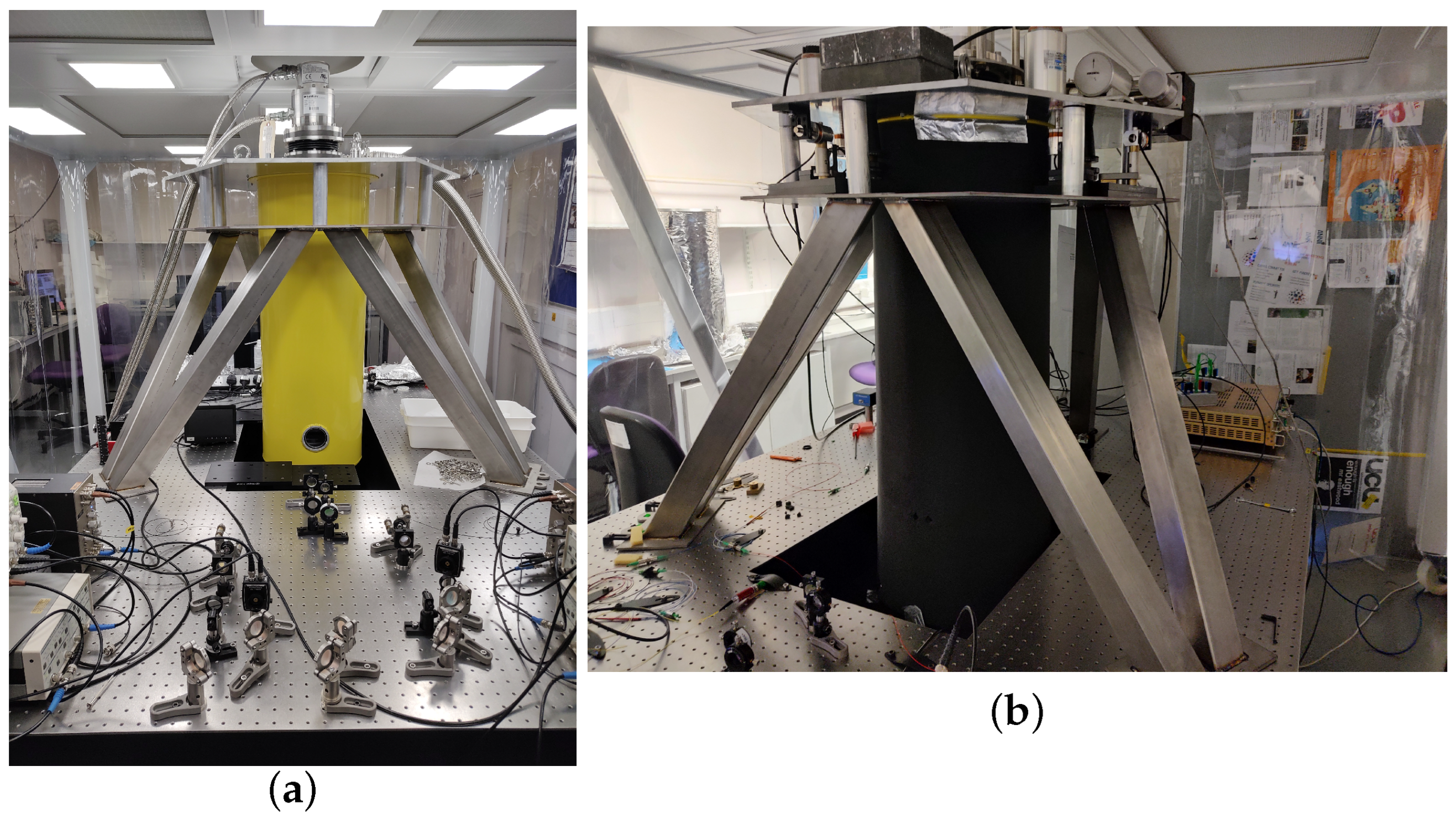
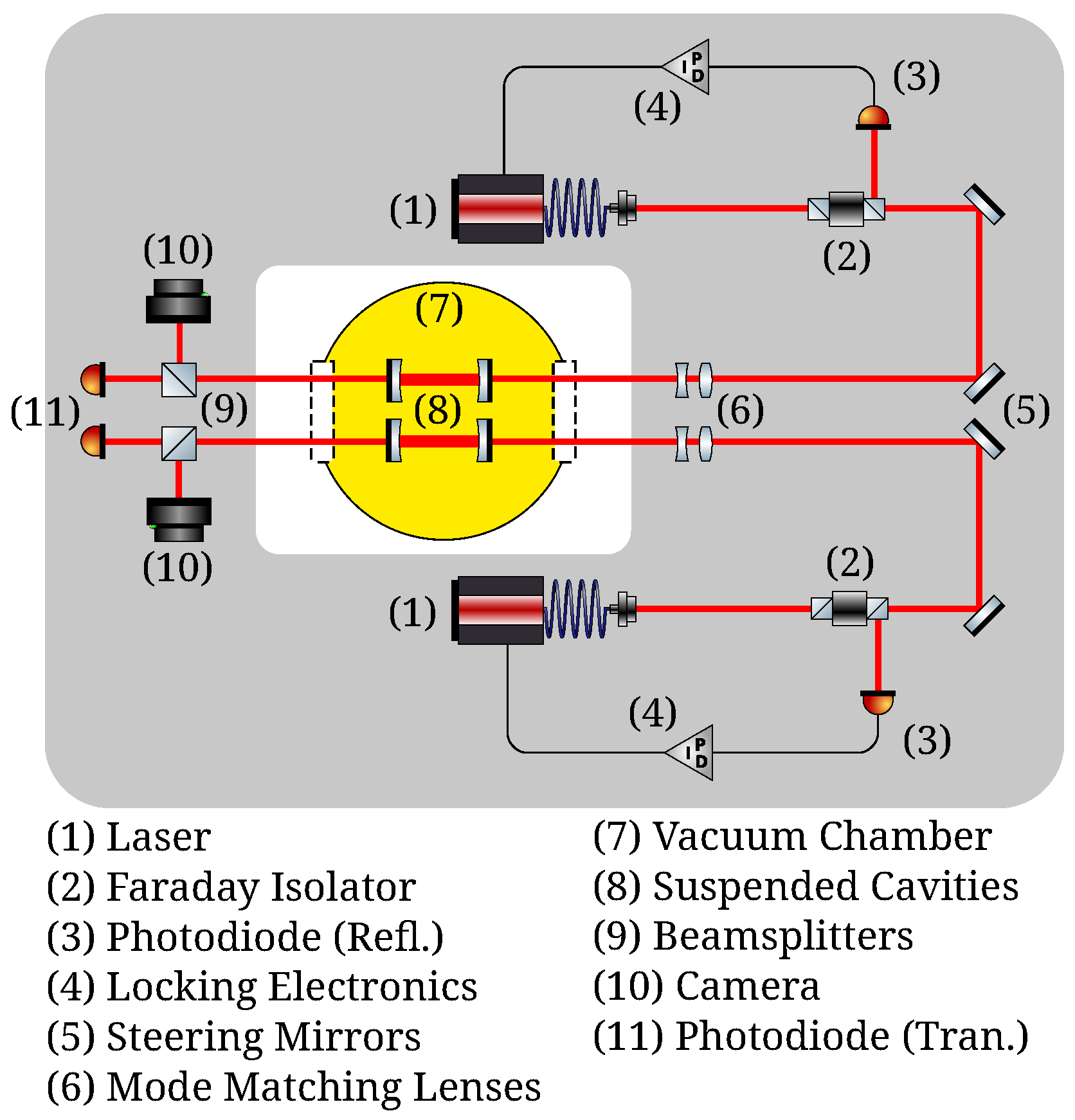
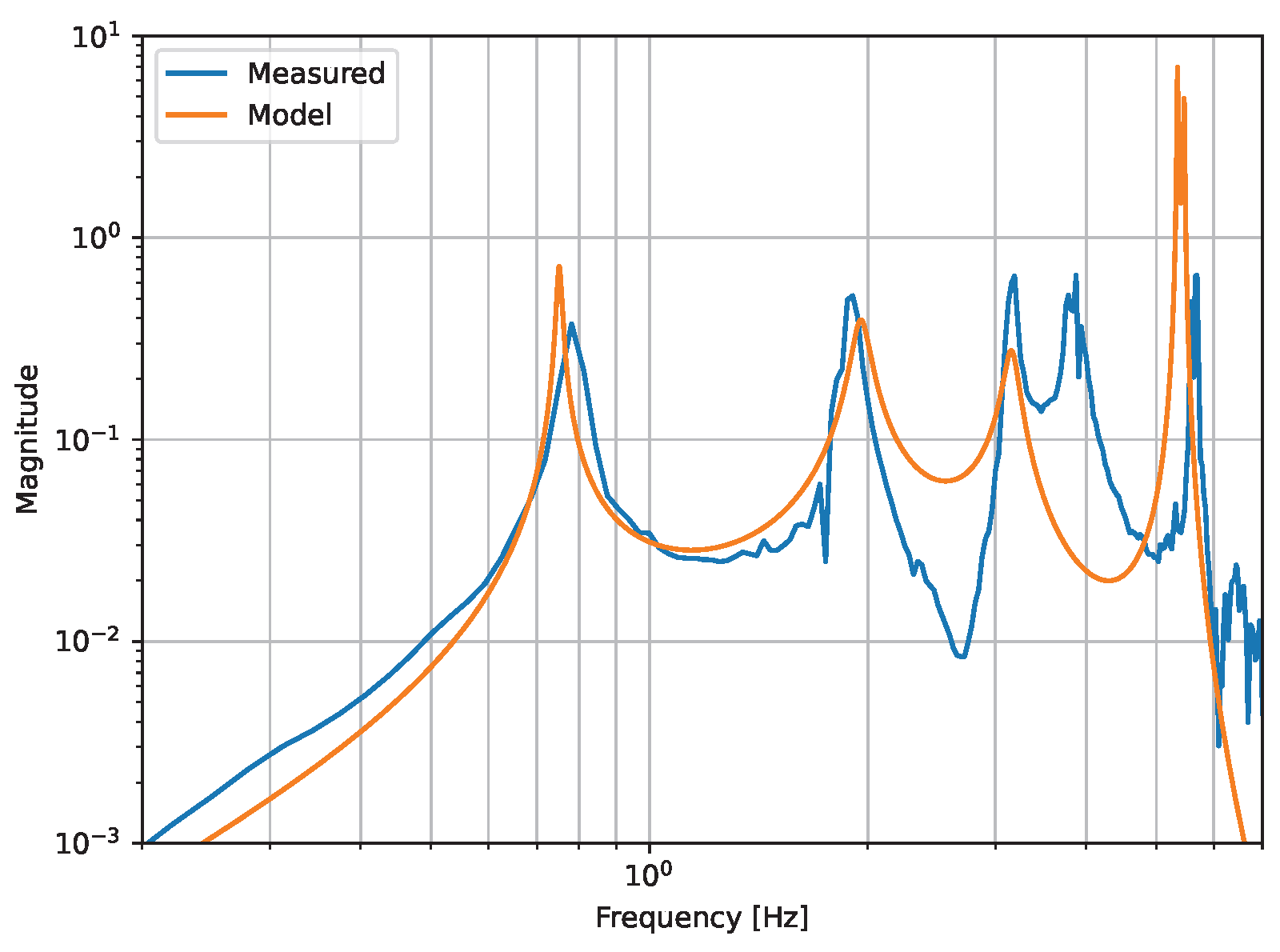
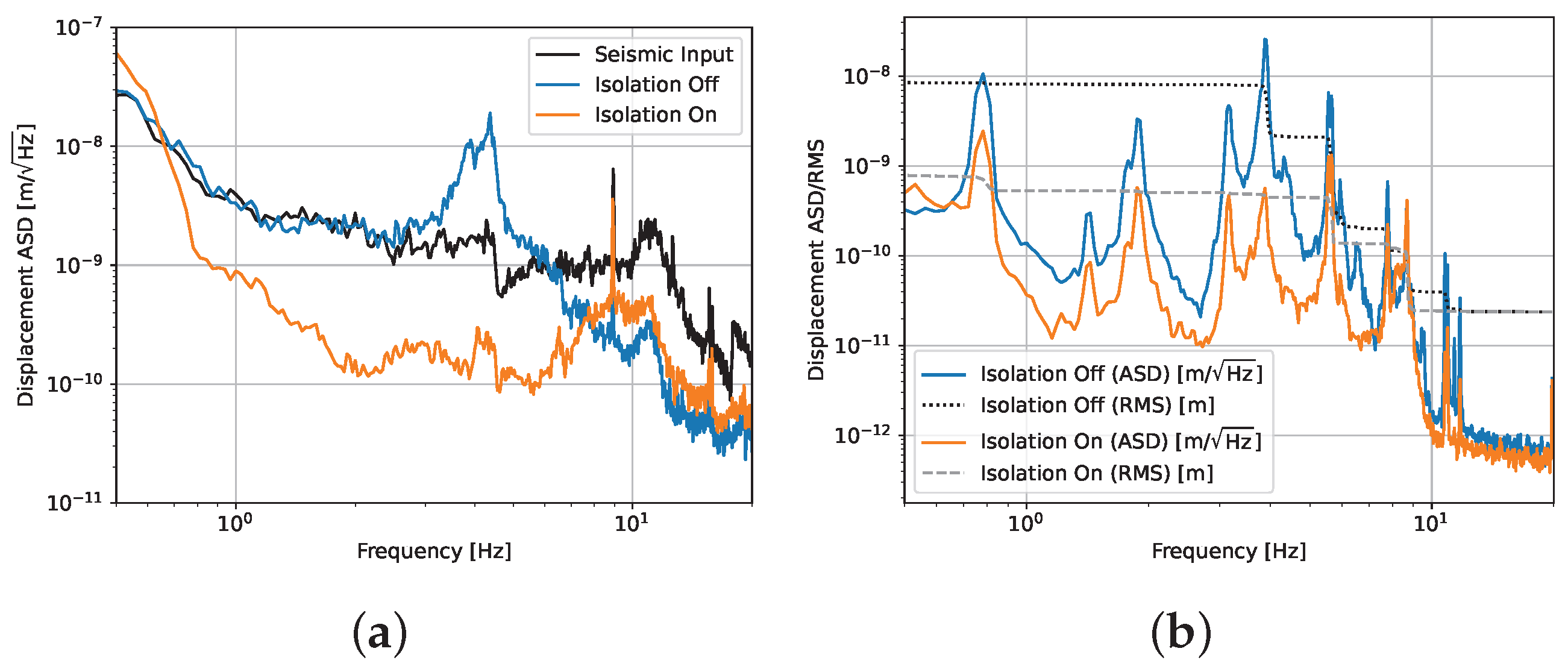
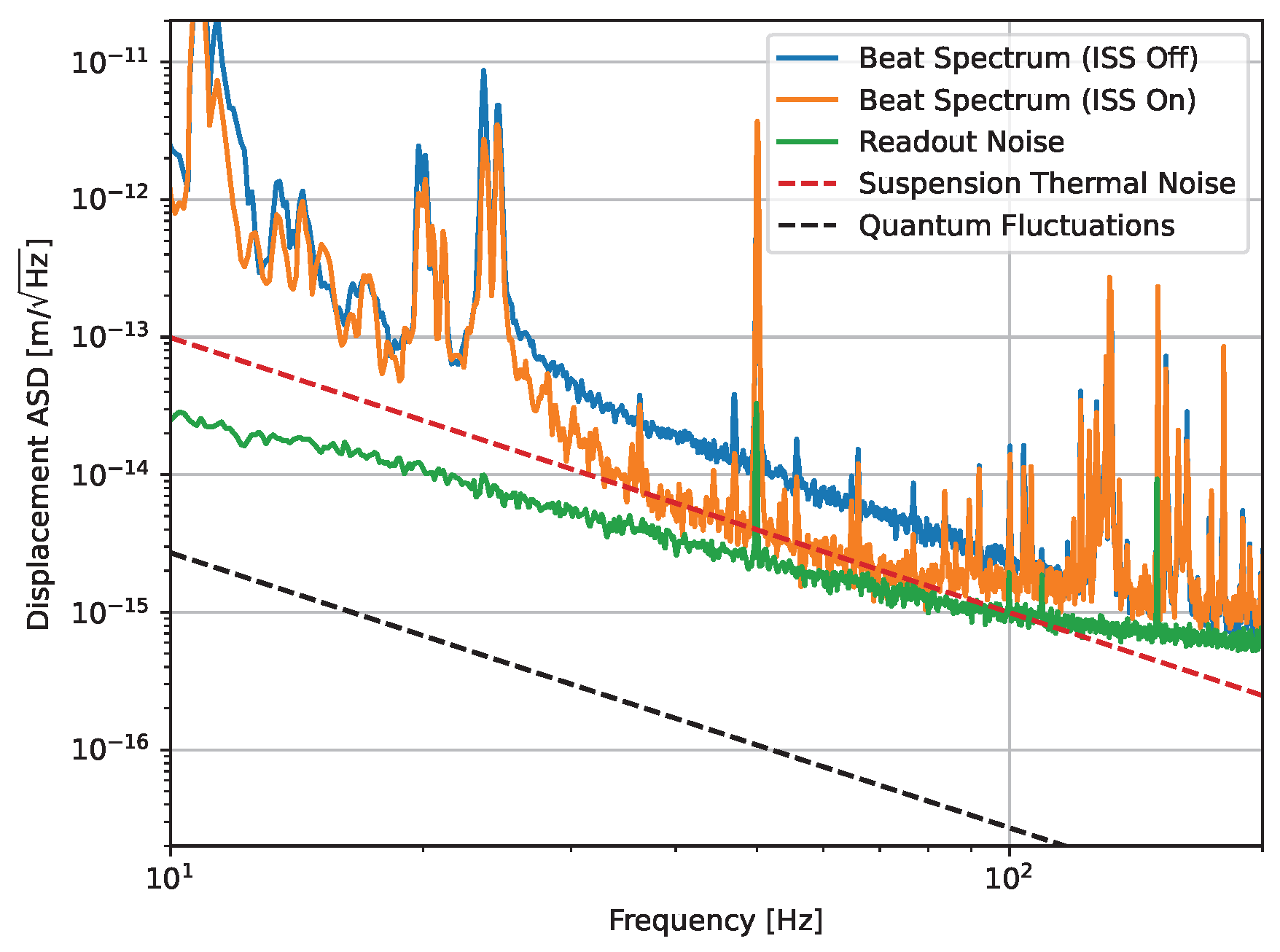
Disclaimer/Publisher’s Note: The statements, opinions and data contained in all publications are solely those of the individual author(s) and contributor(s) and not of MDPI and/or the editor(s). MDPI and/or the editor(s) disclaim responsibility for any injury to people or property resulting from any ideas, methods, instructions or products referred to in the content. |
© 2024 by the authors. Licensee MDPI, Basel, Switzerland. This article is an open access article distributed under the terms and conditions of the Creative Commons Attribution (CC BY) license (https://creativecommons.org/licenses/by/4.0/).
Share and Cite
Smetana, J.; Yan, T.; Boyer, V.; Martynov, D. A High-Finesse Suspended Interferometric Sensor for Macroscopic Quantum Mechanics with Femtometre Sensitivity. Sensors 2024, 24, 2375. https://doi.org/10.3390/s24072375
Smetana J, Yan T, Boyer V, Martynov D. A High-Finesse Suspended Interferometric Sensor for Macroscopic Quantum Mechanics with Femtometre Sensitivity. Sensors. 2024; 24(7):2375. https://doi.org/10.3390/s24072375
Chicago/Turabian StyleSmetana, Jiri, Tianliang Yan, Vincent Boyer, and Denis Martynov. 2024. "A High-Finesse Suspended Interferometric Sensor for Macroscopic Quantum Mechanics with Femtometre Sensitivity" Sensors 24, no. 7: 2375. https://doi.org/10.3390/s24072375
APA StyleSmetana, J., Yan, T., Boyer, V., & Martynov, D. (2024). A High-Finesse Suspended Interferometric Sensor for Macroscopic Quantum Mechanics with Femtometre Sensitivity. Sensors, 24(7), 2375. https://doi.org/10.3390/s24072375





